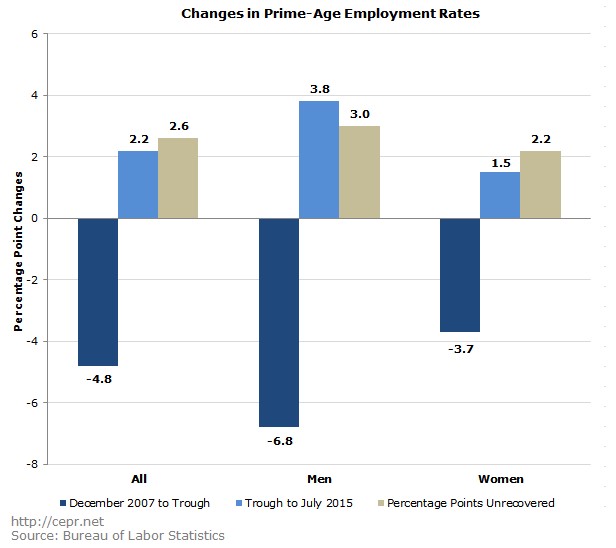The unemployment rate has fallen by nearly a full percentage point over the last year, to 5.3 percent as of July. The number of unemployed Americans has dropped by 1.4 million over that that time. But for all the gains the labor market has made, by at least one important measure, it still isn’t back to pre-recession levels.
The left-leaning Center for Economic and Policy Research noted the other day that the share of the prime working-age population with jobs is still below where it was in December 2007.
Related: The Pain the Job Numbers Don’t Show
Slicing the labor market this way cuts through some of the noise in the usual jobs data, CEPR says. The unemployment rate, for example, leaves out potential workers who are so discouraged by their prospects of finding work that they haven’t actively looked for a job for four weeks or longer. And demographic changes that affect the age distribution of the population could mask the real state of the job market, too: “if the population is aging, a greater percentage of the population may hit retirement age and willingly retire, which doesn’t imply a weaker job market,” CEPR’s Evan Butcher and Nicholas Buffie wrote in a blog post this week. “Conversely, if the population is becoming younger, a greater percentage of the population may enroll in high school or college; yet this tells us nothing about employment opportunities for those who want to work.”
Focusing just on Americans aged 25 to 54 shows what’s happening to the core of the workforce, and CEPR finds that 77.1 percent of that group was employed last month. That’s better than the 74.9 percent of prime-age workers who had jobs at the low point of the economic downturn, in September and October 2011, or the 74.8 percent from November 2010. But it’s still 2.6 percentage points away from the 79.7 percent prime-age employment rate in December 2007. The labor market recovery so far has made up less than half of the prime-age employment lost in the recession.
Related: Hoping for a Raise? Here’s How Much Most People Are Getting
The CEPR researchers add that prime-age employment for men is now 3 percentage points lower than it was in December 2007, while the rate for women is 2.2 percentage points below where it was. “The drop for men was about twice as great as the drop for women; and while men have experienced a stronger recovery than women, the net effect of the initial drop and subsequent recovery has been worse for men than for women,” Butcher and Buffie write.






